Search myodfw.com
This mid-sized, pink-legged gull has caused much of the confusion in west coast gull classification and identification. Its plumage characteristics are similar to Herring, Iceland, and some Glaucous-winged hybrids, and great care is needed for correct identification. It differs from the Herring gull in having a much smaller bill, a darker eye, less black in the wing-tips and, often, a more rounded head. Opportunistic feeders, Thayer's gulls regularly concentrate about landfills, food-processing plants, and over fish runs. It is a common migrant and fairly common winter visitor along the coast. The largest wintering numbers are found in the Portland metropolitan
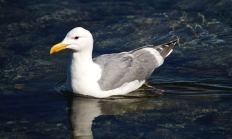
This medium-sized owl is easily recognized by its conspicuous "ear" tufts, yellow eyes set in a round facial disk, size, and mottled plumage of black, brown, gray, buff, and white. Legs and toes are densely feathered. Females are larger and darker in coloration than males. It is strictly nocturnal and secretive during nesting. The Long-eared owl is a fairly common breeder in open country east of the Cascades in wooded riparian areas and junipers. It is a common breeder on Boardman Bombing Range, Morrow County and widespread in Malheur County. It is a rare breeder in the foothills of the

Perhaps the most enigmatic hummingbird found regularly in Oregon, the Broad-tailed hummingbird has so far eluded documentation of its breeding in the state, likely due to identification uncertainties and the remoteness of its preferred habitat. Primarily a Rocky Mountain species, its hard-to-define breeding range seems to reach its limit at Oregon's eastern edges where reports of this beautiful and rare species arise each summer. The relatively large adult male has a rose-red gorget and green plumage with no dorsal Rufous coloration. Females and immatures are nearly indistinguishable in the field from those of the more common Rufous hummingbird. Hear the
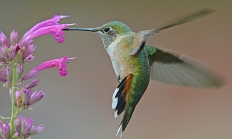
A large and colorful member of the sparrow family, the Green-tailed towhee is perhaps more recognizable by its eye-catching chestnut crown than by its less intense green-gray back and olive tail. As a ground forager, it spends most of its time on the ground or in thick cover, scratching about industriously in the leaf litter, and it may go unnoticed. But its catlike mewing call, which it often gives from a brushy perch, is one of the quintessential sounds of the shrublands of the east slope of the Cascades and the Great Basin. It is locally fairly common east of

The canyon mouse is a moderate to small-sized mouse-like rodent with a long tail, nearly naked ears and a long, lax, and silky dusty gray pelage. In Oregon, most locations where the canyon mouse has been found are in Harney and Malheur counties, but the distribution includes a group of localities in Crook, Jefferson, Wasco, and Wheeler counties and another group in Lake County. There are also records of the species in extreme southeastern Baker County. Rock, primarily rimrock and talus slopes, seems to be the key component of habitats occupied by the canyon mouse. They are usually active nocturnally
A medium-sized hawk, the Red-shouldered hawk has bold black-and-white flight feathers and rusty shoulder patches. Seen in flight from underneath, especially when lit from the sun, its wings show a translucent 'window' near the tips. It relies on perches for hunting and is closely affiliated with wooded wetlands and riparian bottomlands. In the breeding season this hawk is found in moist woodlands with at least a few deciduous trees. It prefers riparian bottoms, especially those near shallow wetlands or open meadows. In winter, it may use more open lands such as found in the Rogue and Willamette valleys, depending on
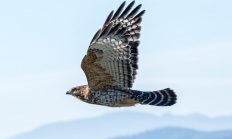
Oregon has two species of pelicans, American white and the Brown pelican, and three species of cormorants. All are fish-eating water birds with four toes joined by webbing. Depending on the species, pelicans and cormorants inhabit the Oregon coast, rivers or interior waterbodies.

Features: Their eyed-side is greenish-brown to dark brown or black with lighter blotches. Their blind side is white to milky-white. They have a large, stout but flat body, shaped like an elongated diamond . Pacific halibut have been known to reach 500 pounds, but on average are 40 pounds. Habitat: Halibut are a large flatfish and so they spend much time near the bottom of the ocean looking above for food. They prefer chilly water and are primarily found in the Gulf of Alaska. Technique: Boat anglers use heavy rods to fish on or near gravel bottoms in water 150-500

The Greater sandhill crane is Oregon's tallest bird. This large majestic crane has a guttural gurgling or bugling call, and is easily noticed in flight by its profile, with long neck and head extending straight ahead and long legs trailing behind. The Greater sandhill crane is distinguished by its red crown and white cheek patches, contrasting with with a light gray body. Fledged young resemble adults, but have a feathered forehead, a lighter tawny plumage, and lack the red crown and white cheek patches during their first fall. Fledged young have a squeaky cheap call often heard in flight during
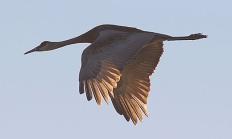
The Buff-breasted sandpiper resembles a plover with a high-stepping, pigeon-like gait. One of the few Oregon shorebirds that frequents dry, sparsely vegetated coastal grasslands. Fall migrants consist of juveniles. It has scaly, buffy-brown underparts, yellow legs, a small head, and a short black bill. Beady black eyes stand out on a plain, pale face. It bobs its head while moving. Gleaming white underwings are displayed in a graceful flight pattern. It is unique among North American shorebirds in having a lek mating system. This is a rare but regular fall migrant on the Oregon coast where it has been recorded
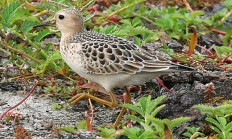
Anna's hummingbird is the largest hummingbird common to our region. It is the only hummingbird regularly found in Oregon in winter, during which time it is exposed to short day lengths, limited sources of food and periods of intense cold. It is more vocal than most hummingbirds with males uttering a dry, scratchy buzz of a song that can be heard throughout the year. It is a rare to locally uncommon summer resident west of the Cascades in interior valleys and along the coast; also along the Columbia River east to The Dalles. It occurs and probably breeds into the
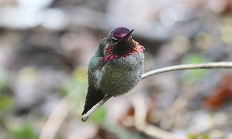
A white form on the distant water may be the sides and breast of an adult male, whose deep green head and dark back are less visable when far away. The pearl gray bodies and white breasts of females, subadults, and eclipse males are starkly delineated from their full-crested chestnut heads. Long, slender, saw-tooth bills are held horizontally during surface swimming and grip squirming prey after an underwater chase. From coastal bays to the high Cascades, in all corners of Oregon and far beyond, common mergansers ply the rivers and peer into still waters in their efficient pursuit of fish

Even in the most barren and desolate reaches of the Great Basin, the cheerful song of the hardy Rock wren will contradict any notion that the desert is devoid of life. This specialist of cracks and crevices can be found almost anywhere there is exposed rock. One of its most unique features is the mysterious pebble path is constructs from its stone-cave nest to the outside entrance. Drab and pale overall, the gray head and back, white to tawny underparts, and gray tail with buff-tipped corners distinguish this species from other wrens. The Rock wren is a common breeder in

The Veery is known less for its appearance than for its ethereal song, a series of spiraling, reverberating flutelike notes, each lower in pitch, suggesting the name: vee-ur, vee-ur, vee-ur. A patient observer may get a fleeting glimpse of a small thrush with reddish brown upperparts, pale undersides, and a buffy upper breast with a few darker spots. It is an uncommon breeder in lower to middle elevations in the Blue Mountains where sufficient riparian thickets exist for cover and forage needs. It is locally common along watercourses in Union, Wallowa, and east Umatilla counties, and less common in north

Features: Spiny dogfish are gray or brown with white spots on their back and a white belly. They can grow to be 5-feet long. They are called "spiny" as they have a spine behind each of the fins on their backs. Habitat: Spiny dogfish are widely dispersed, traveling from Alaska to Chile, and from intertidal waters down to 3,000 feet. They mostly eat small fish, squid, and octopus. Techniques: Being relatively small, spiny dogfish can be taken with light tackle. They tend to school around prey over soft bottoms. A good amount of weight will probably be necessary to keep

This bat, found in older forests, has a wingspan of about 10 inches. Its fur is glossy black, tipped with white. It forages over ponds, streams, meadows and roads, often flying very low and roosting behind loose tree bark. Maternity roosts of the silver-haired bat are found in trees. This bat usually bears twins. The silver-haired bat occurs statewide in Oregon except for most of the Columbia Basin and is an Oregon Conservation Strategy Species in all ecoregions except the Nearshore ecoregion. It is primarily associated with coniferous forests, including the juniper woodlands in the southeastern portion of the state

Features: Coastal cutthroat trout are typically are blue/green on top, red along the lateral line, and white on the belly. They are lightly or heavily spotted and adults have a red slash mark on the throat. Habitat: The most common variety of trout in Oregon is the coastal cutthroat, found in the streams and beaver ponds in coastal drainages. They also are stocked in high mountain hike-in lakes where the water stays cool throughout the summer. Techniques: Cutthroats that are year-round residents of small streams may not get any bigger than 8- or 9-inches, but can reward the angler with
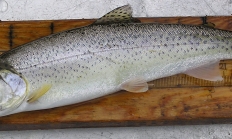

The mottled petrel breeds in New Zealand and nearby islands, and ranges throughout much of the Pacific Ocean, mostly far from land. It is a common May to October visitant in the northern and eastern North Pacific, with non-breeding birds occurring during the winter months. Photo by Dominique, Flickr

Swans, ducks and geese belong to the Anatidae family and occur on all continents. Special oils let their feathers shed water, so they are adapted for swimming and floating, and some are even talented divers. For tips on discouraging geese from overwhelming your yard, check our Living with Wildlife, Birds page.

